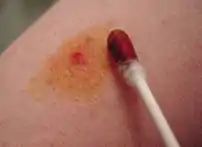 | |
| Clinical data | |
|---|---|
| Trade names | Iodoflex, Iodosorb, others |
| AHFS/Drugs.com | Monograph |
| License data | |
| Routes of administration | topical, by mouth, IM |
| ATC code | |
| Legal status | |
| Legal status | |
| Identifiers | |
| CAS Number | |
| UNII | |
Iodine is used to treat and prevent iodine deficiency and as an antiseptic.[2][3] For iodine deficiency[4] it can be given by mouth or injection into a muscle.[2] As an antiseptic it may be used on wounds that are wet or to disinfect the skin before surgery.[3]
Common side effects when applied to the skin include irritation and discoloration.[3] When taken by mouth or injection side effects may include allergic reactions, goitre, and thyroid dysfunction.[2] Use during pregnancy is recommended in regions where deficiency is common, otherwise it is not recommended.[2][3] Iodine is an essential trace element.[2]
In 1811, Bernard Courtois isolated iodine from seaweed while in 1820 Jean-Francois Coindet linked iodine intake to goiter size.[5] It initially came into use as a disinfectant and for goiter.[6][7] It is on the World Health Organization's List of Essential Medicines.[8] Table salt with iodine, known as iodized salt, is available in more than 110 countries.[9]
Formulations
A number of iodine containing formulations are also used medically including:[10]
- Potassium iodide (supplement)
- Lugol’s solution (supplement and disinfectant)
- Povidone-iodine (disinfectant)
- Iohexol (contrast agent)
- Amidotrizoate (contrast agent)
- Meglumine iotroxate (contrast agent)
- Radioactive iodine
- Tincture of iodine
- So-called nascent iodine
- Iopanoic acid (contrast agent)
- Amiodarone (30% iodine content)
References
- ↑ "FDA-sourced list of all drugs with black box warnings (Use Download Full Results and View Query links.)". nctr-crs.fda.gov. FDA. Retrieved 22 October 2023.
- 1 2 3 4 5 World Health Organization (2009). Stuart MC, Kouimtzi M, Hill SR (eds.). WHO Model Formulary 2008. World Health Organization. p. 499. hdl:10665/44053. ISBN 9789241547659.
- 1 2 3 4 "Iodine". The American Society of Health-System Pharmacists. Archived from the original on 13 January 2017. Retrieved 8 January 2017.
- ↑ "Iodine Deficiency". American Thyroid Association. Retrieved 18 November 2022.
- ↑ Leung AM, Braverman LE, Pearce EN (November 2012). "History of U.S. iodine fortification and supplementation". Nutrients. 4 (11): 1740–1746. doi:10.3390/nu4111740. PMC 3509517. PMID 23201844.
- ↑ Starke JA (2009). "14. Application of Iodine Water Purification Tablets: Iodine's Efficacy against Cryptosporidium parvum.". In Preedy VR, Burrow GN, Watson RR (eds.). Comprehensive Handbook of Iodine: Nutritional, Biochemical, Pathological and Therapeutic Aspects. Academic Press. p. 135. ISBN 9780080920863. Archived from the original on 12 August 2017.
- ↑ Sneader W (2005). "Legacy of the Past". Drug Discovery: A History. John Wiley & Sons. ISBN 9780471899792. Archived from the original on 13 January 2017.
- ↑ World Health Organization (2019). World Health Organization model list of essential medicines: 21st list 2019. Geneva: World Health Organization. hdl:10665/325771. WHO/MVP/EMP/IAU/2019.06. License: CC BY-NC-SA 3.0 IGO.
- ↑ Wesley AS, Horton S (2010). "Economics of Food Fortification". In Watson RR, Gerald JK, Preedy VR (eds.). Nutrients, Dietary Supplements, and Nutriceuticals: Cost Analysis Versus Clinical Benefits. Springer Science & Business Media. p. 37. ISBN 9781607613084. Archived from the original on 13 January 2017.
- ↑ World Health Organization (2015). The selection and use of essential medicines. Twentieth report of the WHO Expert Committee 2015 (including 19th WHO Model List of Essential Medicines and 5th WHO Model List of Essential Medicines for Children). Geneva: World Health Organization. hdl:10665/189763. ISBN 9789241209946. ISSN 0512-3054. WHO technical report series;994.
External links
- "Iodine". Drug Information Portal. U.S. National Library of Medicine.